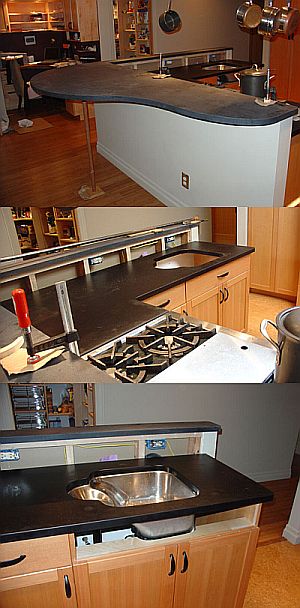Question
I had a customer a while back who decided to use Richlite SS in their kitchen. The countertops were fabricated by an authorized dealer and installed by me. Both the owner and I am delighted with the results, after almost two years the counter has acquired a wonderful patina and looks like it did the day it was installed.
My latest client decided to go with a similar material, Paperstone (actually, to my eyes it looks indistinguishable). I now have in my shop 2 slabs to work with, they are both 1Ό thick - one is 60 X 144 and the other is 60 X 96. Needless to say, they are not easily tossed around. Other than toying with a couple of scraps I have never worked with the stuff, so Im asking for any tips on fabricating this material.
For this job, I have to cut each piece into an appropriately sized L shape and scribe to the walls, and then cut a hole through each piece for two undermount sinks so I need them to be exact size, with finished edges, and small roundovers.
How about the finished countertop edges - should they be cut 1/8 oversize and routed to finish size? How about cutting the inside 90Ί corners any tricks? Should they be rounded slightly? For the undermount sinks, should I use the same general procedure? If I rout, should I use a plunge router with the template or just cut the opening slightly undersized and rout with a standard setup? Do I use a straight cutter or spiral upcut?
What about finish sanding? Right now if you look in an oblique light the top surface appears to have slight horizontal striations in it are these sanding marks from the manufacturing process? And more importantly, will they go away with an overall finish sanding? I certainly dont want to make any mistakes, these slabs were not cheap. I appreciate any help.
Forum Responses
(Laminate and Solid Surfacing Forum)
From contributor A:
For the L's, fabricate each leg out of a separate piece, epoxy them together with biscuits. Then you have a sharp inside corner. I have done it the other way before - cut from one piece, routed, and then squared the corner off with a jigsaw, and sanding blocks. It was rather dicey.
Make all cuts slightly oversized, trim with a router with a large pattern bit, then belt sand the router marks off. Finish sand the edges with a random orbit sander. Sand the tops with an orbital, using progressive grits. Don't sand too much - I've been told that you can sand through the kraft paper layers and get some linear artifacts because of it. I've also done these countertops without sanding the surface - it depends on the surface finish you're after.
All in all I'm beginning to think this process will turn out to be much easier than I'm imagining, and after I finally start cutting into the stuff I'll be relieved - and probably the hardest part will be just getting the 12 by 5 foot beast (I estimate a bit under 500 lbs after I cut the sinks and L shaped cutout) into the house and on the cabinets without breaking my back or punching through a wall. I guess I'll just have to round up a few hefty guys who can follow directions.
